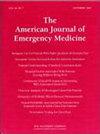利用韩国国家急诊科信息系统(NEDIS)数据库更新严重创伤评分系统。
IF 2.7
3区 医学
Q1 EMERGENCY MEDICINE
引用次数: 0
摘要
背景:评估严重创伤患者时使用了各种评分系统,其中最常用的工具之一是根据诊断代码计算的生存风险比(SRR)得出的国际疾病分类伤害严重程度评分(ICISS)标准。本研究旨在根据诊断代码的 SRR 重新定义韩国的严重创伤评分系统,并随后评估其在预测创伤患者生存结果方面的性能:本研究利用韩国国家急诊科信息系统(NEDIS)数据库,纳入了2016年1月至2019年12月期间在一级和二级急诊科(ED)就诊的创伤患者。本研究的主要结果是院内死亡率。我们计算了865个创伤诊断代码(韩国疾病标准分类[KCD-7]代码,4位数格式)中每个代码的新SRR-2020值,并根据患者诊断乘以相应的SRR-2020值得出患者特异性ICISS-2020值。我们比较了 ICISS 对严重创伤患者院内死亡率的预测性能:共登记了 3,841,122 例患者,院内死亡率为 0.5%。使用 ICISS-2020 的严重创伤患者 结论:新开发的 ICISS-2020 利用全国范围内的急诊患者数据库,在预测创伤患者的生存结果方面表现相对较好(准确性、特异性、PPV、LR+ 和 AUROC)。本文章由计算机程序翻译,如有差异,请以英文原文为准。
An update of the severe trauma scoring system using the Korean National Emergency Department Information System (NEDIS) database
Background
Various scoring systems are utilized to assess severe trauma patients, with one of the most commonly used tools being the International Classification of Diseases Injury Severity Score (ICISS) criteria derived from the Survival Risk Ratio (SRR) calculated using diagnostic codes. This study aimed to redefine the severe trauma scoring system in Korea based on the SRR for diagnostic codes, and subsequently evaluate its performance in predicting survival outcomes for trauma patients.
Methods
This study included trauma patients who visited Level 1 and 2 emergency departments (EDs) between January 2016 and December 2019, utilizing the Korean National Emergency Department Information System (NEDIS) database. The primary outcome of this study was in-hospital mortality. The new SRR-2020 value was calculated for each of the 865 trauma diagnosis codes (Korean Standard Classification of Diseases [KCD-7] codes, 4-digit format), and the patient-specific ICISS-2020 value was derived by multiplying the corresponding SRR-2020 value based on patient diagnosis. We compared the predictive performance for in-hospital mortality between severe trauma patients with an ICISS <0.9 based on the newly developed ICISS-2020 version and those defined by the previously used ICISS-2015 version.
Results
A total of 3,841,122 patients were enrolled, with an in-hospital mortality rate of 0.5 %. Severe trauma patients with ICISS-2020 < 0.9 accounted for 5.3 % (204,897 cases) that was lower than ICISS-2015 < 0.9 accounting for 15.3 % (587,801 cases). Among the 20,619 in-hospital mortality cases, 81.4 % had ICISS-2020 < 0.9, and 88.6 % had ICISS-2015 < 0.9. When comparing predictive performance for in-hospital mortality between the two ICISS versions, ICISS-2020 showed higher accuracy (0.95), specificity (0.95), positive predictive value (PPV) (0.08), positive likelihood ratio (LR+) (16.53), and area under the receiver operating characteristic curve (AUROC) (0.96) than ICISS-2015 for accuracy (0.85), sensitivity (0.88), specificity (0.85), PPV (0.03), LR+ (5.94), and AUROC (0.94). However, regarding sensitivity, ICISS-2020 < 0.9 showed a lower value of 0.81 compared to ICISS-2015 < 0.9, which was 0.88. The negative predictive value (NPV) was 1.00 for both versions.
Conclusions
The newly developed ICISS-2020, utilizing a nationwide emergency patient database, demonstrated relatively good performance (accuracy, specificity, PPV, LR+, and AUROC) in predicting survival outcomes for patients with trauma.
求助全文
通过发布文献求助,成功后即可免费获取论文全文。
去求助
来源期刊
CiteScore
6.00
自引率
5.60%
发文量
730
审稿时长
42 days
期刊介绍:
A distinctive blend of practicality and scholarliness makes the American Journal of Emergency Medicine a key source for information on emergency medical care. Covering all activities concerned with emergency medicine, it is the journal to turn to for information to help increase the ability to understand, recognize and treat emergency conditions. Issues contain clinical articles, case reports, review articles, editorials, international notes, book reviews and more.

 求助内容:
求助内容: 应助结果提醒方式:
应助结果提醒方式:


